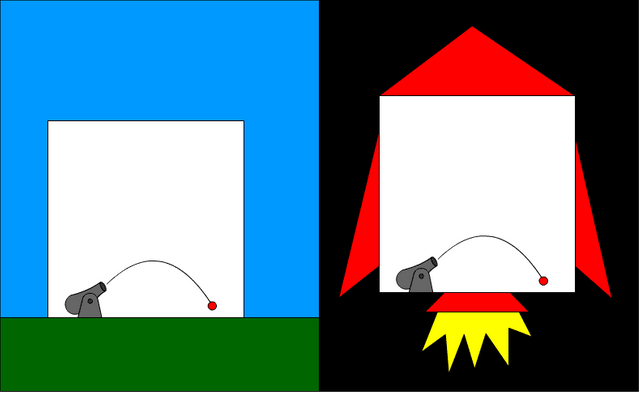What is relativity?
RELATIVITY

What’s it all about?
Contents
- 1 What’s it all about?
- 2 Why is it Special?
- 3 Build your own Time Machine
- 4 That Shrinking Feeling
- 5 General
Speed. More precisely a very specific speed. Even more precisely 299,792,458 ms-1, the speed of light. This magic mysterious speed is at the heart of relativity. Its was Einstein’s pondering of this speed that lead to some of the most amazing physics ideas ever. Relativity comes in two forms, Special and General. A physicist once said that given enough time someone else would have come up with Special relativity, General Relativity on the other hand was a stroke of such genius were it not for Einstein the idea may never have come about.As a brief overview
- Special Relativity is the theory that no matter what constant speed you’re travelling all the laws of physics are the same.
- General Relativity says that being at rest in a gravitational field and accelerating are physically identical.
Together these two show that no matter how you’re moving all the laws of physics work the same, and so you can treat yourself as if you were at rest.
Why is it Special?
Special Relativity is special because it only deals with simple systems. Systems where things are moving in nice straight lines at nice constant velocities. No forces. No acceleration. Einstein developed 2 postulates of special relativity
- All physical laws are the same whatever constant velocity you are moving at
- The speed of light is always the same, independent of the motion of the observer or light source
These mean that there is no absolute motion. If you’re in a car going at 50 mph there is no way you can prove you are even moving. It could be the earth and everything on it except you and the car is moving backwards at 50 mph, and if you wanted to say that was happening you wouldn’t be wrong, the laws of physics would back it up. All you can say is that one thing is moving RELATIVE to another, which one you pick as a stationary reference frame is up to you.From the two postulates of Special Relativity come some very important consequences.
- Time Dilation
- Length Contraction
Let’s look at how these come about.
Build your own Time Machine
One of the above implications of Special Relativity is Time Dilation. What this means is due to the speed of light being invariant, and all laws being the same for constant velocities, time can slow down. Time, it turns out, is not a constant throughout the universe but is totally relative.Imagine you’re on a space ship and in you’re hand you have a fancy new type of clock you’ve invented. It’s basically two mirrors that a photon bounces between and you’ve set it up so that every time the photon hits one of the mirrors you hear a click. You’ve also set it up so that you know how many clicks you will hear in one second, so providing you are good at counting you can measure time very accurately with this clock.Now let’s assume your space ship is currently stationary. Luckily one side is made of glass so we can see what’s going on.The photon would go up to the top mirror and set off a “Click” and then bounce down to the bottom mirror and set off another “Click”. Then it would bounce back up and back down again, over and over again. Simple and easy.Now let’s assume you decide to take the space ship for a quick spin. So now you’re moving along at a constant velocity. All the laws that applied before still hold now, but as you can see form the below image, something has changed.As you’re travelling along, so is the clock, so when the proton sets of for the top mirror it’s no longer a straight journey up. It has to travel diagonally, which as you can see is a much longer path. So the time between clicks will be longer. So for an observer time on the ship slows down. HOWEVER, from your point of view on the ship it’s not a diagonal journey, it’s just straight up and down, so time is running normally.So there is a discrepancy. Your clock on board is showing a different time to one for example on earth, and even though they are both different they are both still correct. And it is because of this that time travel is possibleThe faster you travel the more time slows down. If you and a friend started on earth with two synchronised clocks, and then you took a trip at 99% the speed of light for 1 day, when you returned your friends clock would be almost exactly 6 days ahead of yours. Effectively you just spent a day travelling a week into the future!!Using some simple trigonometry you can work out an equation for how much time differs as you move along at your constant velocity. In the case of you being stationary then the clock situation isThe situation where it is taken that nothing is moving is called the Rest Frame. The time you measure between clicks in the rest frame will be given by (just a simple Distance/Speed calculation)(1) When you are moving along at a constant speed, , the situation will beSo the time between clicks will be(2) Using Pythagoras’s law for right handed triangles we can calculate the distance . The height of the triangle will be , and the length across the bottom will be however far the clock has moved in one click, so (speed times time is distance) We can substitute this expression for into Equation 2, and then rearrange for , which gives If we now replace with (from Equation 1) we get the Equation for Time Dilation(3) This equation tells you how much the moving clock () will differ from a rest frame clock ().For most of the values of we are used to in everyday life the ratio is tiny, so the denominator of Equation 3 is usually so close to 1 that we cant detect any difference and so we find that =. For example; two people synchronise watches, and then one of them travels at 120 mph. If the stationary person records a time of 30 seconds then the moving person will record a time of 29.99999999999952 seconds. This difference is far too small to measure, even with the best technology, so at low speeds compared to the speed of light, we don’t really notice the effects of relativity.
That Shrinking Feeling
As already stated, The Speed of Light is always the same, but as we have just found out, time can slow down if you are moving fast enough. Speed is calculated as distance travelled divided by time, but if time can change then so must distance, in order to keep the speed of light constant.If time is getting bigger by a set factor then distance should get smaller by the same factor in order to leave the speed of light unchanged for a moving observer. So our equation for Length Contraction is(4) The bit in the square root turns up all over the place in relativity so it is usually abbreviated as This is called the Lorentz Factor after the physicist Hendrik Lorentz (the same Lorentz who came up with the Lorentz force), whos equations and transformations are used in relativity.
General

Congratulations @tintutick! You have completed some achievement on Steemit and have been rewarded with new badge(s) :
Click on any badge to view your own Board of Honor on SteemitBoard.
For more information about SteemitBoard, click here
If you no longer want to receive notifications, reply to this comment with the word
STOPGood
I like your post
Good
trueth